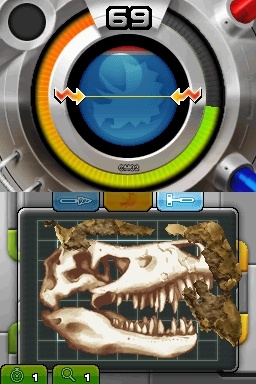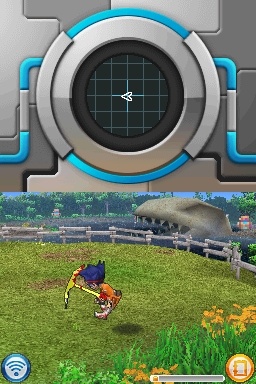2009's Fossil Fighters proved to be a refreshing take on the style of collecting creatures and battling popularized by the Pokemon series. Now, Fossil Fighters: Champions lets you return to the noble tradition of reviving dinosaurs and forcing them to fight each other in violent contests for your own glory. Unfortunately, Champions does little to build on the mechanics of its predecessor, making this a retread of familiar territory that is best suited for those who just couldn't get enough of the original game.
Champions casts you as an eager young fossil fighter--either male or female and named by you--who comes to the Caliosteo Fossil Park to battle it out for the Caliosteo Cup. You meet an amusing assortment of caricatures on the three islands of Caliosteo. These include park proprietor and stereotypical cowboy Joe Wildwest; scatterbrained academic Nigel Scatterly; and Cole, a horrible hipster who blames a loss on the fact that he wasn't wearing his "lucky trucker hat." These broad personalities bring some humor to your quest, and it's pleasant to discover that certain characters who at first seem unlikable prove to be sympathetic. But these charms aren't enough to overcome the repetitive and much-too-familiar feeling of actually playing the game.
As in the original Fossil Fighters, there are three main activities in Champions: digging, cleaning, and battling. Digging up fossil rocks is as dull as ever. You simply use sonar to reveal the locations of rocks and then press a button to dig for them. As you progress through the game, new fossil fields are made available, and there's a bit of fun to be had in exploring an area for the first time and knowing that you're collecting fossils you couldn't access before. But the act of digging is so basic that it quickly becomes a drag, regardless of your surroundings.
After you've gathered some fossil rocks, you need to haul them back to town and clean them to reveal the fossils trapped inside. The first step of this process has you whacking the rock with a hammer by tapping the stylus on the touch screen, which quickly clears away layers of rock but can easily damage the underlying fossil. Once the hammer has done its work, you need to switch to the drill, which is a precise tool that can clean away lingering rock chips. You only have a limited amount of time, so there's pressure to act quickly and efficiently. At the same time, damaging the fossil during the cleaning process makes it less powerful, so you need to balance that speed with caution.
Champions introduces a few new types of fossil rocks, including curious rocks that need to be flipped over and cleaned on both sides, as well as giant rocks that are too large to fit entirely on the screen and need to be slid around as you clean them. But the actual process of cleaning is almost identical to that in the previous game, and although there's initially some satisfaction in cleaning a fossil effectively, this minigame soon becomes tiresome. It's good, then, that your robotic cleaning assistant KL-33N returns from the previous game. After it has observed several of your cleanings, you can drop fossil rocks off with it and it will clean them. However, it can only clean fossil rocks of a type that it has watched you clean before, so as long as you're unearthing new types of fossils, you need to do a fair amount of cleaning yourself.

The third and most significant activity in Champions' triumvirate is battling with creatures that have been revived from your fossils. When you collect a fossil of an ancient creature's head, that creature is revived and joins your stable of revived beasts called vivosaurs. Most of these creatures resemble dinosaurs, but some look like flightless birds, saber-toothed cats, or aquatic creatures. Though some of these beasts are clearly modeled on actual dinosaurs, such as the triceratops and the brachiosaurus, these versions owe no more to scientific fact than Pikachu does. (A real hypacrosaurus probably didn't have the ability to cast mother's care and eliminate all status effects on a specific ally, for instance.)
You assemble teams of up to five vivosaurs and decide on a formation. You can either have two dinosaurs in your attack zone and one in your support zone, or vice versa. (You can also have two in reserve that do not participate in the battle but earn battle points; the game's version of experience.) Your choice of formation is tactically important; some vivosaurs do more damage from the close range of the attack zone while others are more effective from the support zone. Additionally, vivosaurs have effects that they convey on those in the attack zone while in the support zone, and these can be both detrimental and beneficial. These concerns make assembling teams of vivosaurs that work well together an involving process, but like most everything else about the game, this aspect has changed little from the previous entry.
Once your vivosaurs are on the battlefield, you and your opponent take turns until one contestant's vivosaurs are all defeated. You earn fossil power with each turn and spend this power to use your vivosaurs' attacks and other abilities. You can either spend each turn's allotment of fossil power to use your vivosaurs' weaker, less-costly abilities or save the power up to use more powerful abilities on subsequent turns. In battles between well-matched teams, this can lead to some tense tactical decision making, but it's easy to find yourself with teams of vivosaurs that can wipe the floor with most of the competition you encounter. You can create multiple teams of vivosaurs and deliberately use weaker vivosaurs in your collection for more of a challenge (and to level up those vivosaurs), but your path to victory can be easy as pie. Champions aims to be frustration free, and defeat in battle is never a setback. There are no consequences for failure, and if you do come across a key battle you just can't win, you can easily battle random fossil fighters until you and your vivosaurs are powerful enough to triumph.
The one area in which Champions improves significantly on the original game is in its multiplayer offerings. In addition to local multiplayer combat and fossil rock trading, you can now battle with distant friends or random opponents via Nintendo Wi-Fi Connection. Locally, you can also host cleaning parties, where you and your friends help each other clean fossil rocks, and if you're successful, all of you get to add the cleaned fossil to your collections.

The visuals have seen no such enhancements, but they remain pleasant enough. Though they are supposed to be massive creatures, vivosaurs still look as if they could fit in the palm of your hand, which makes their attempts to appear ferocious more endearing than scary (like a cute little dog whose bark is much worse than its bite). The environments you explore in your hunt for fossils don't have much detail, but there's a good variety to them, from the volcanic slopes of Mt. Krakanak to the snowy grounds of Hot Spring Heights.
With more than 140 vivosaurs to discover, there's plenty in Champions to keep you busy for a long time, but the gameplay is too familiar to keep the process of digging, cleaning, and battling compelling for long. The original Fossil Fighters was an enjoyable discovery; this sequel has far too much in common with its predecessor to represent the next stage of the evolutionary chain.